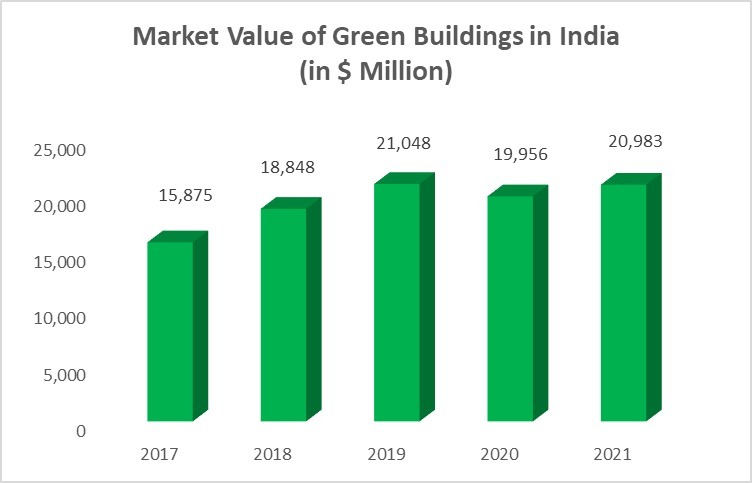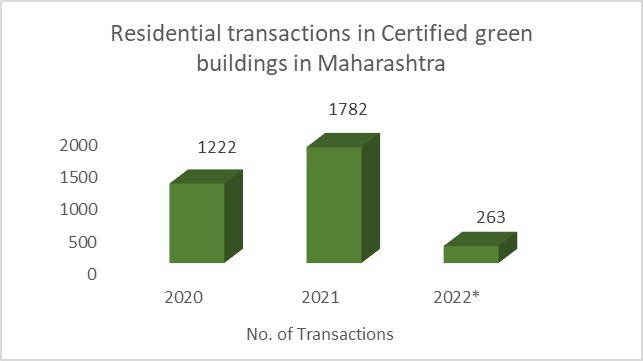Built environment around the world generates about 50% of annual global CO2 emissions. However, the same industry presented green buildings as an emerging market, reaching a total worth of $20,983 million in India as of 2021. While the industry is still facing challenges to upturn green buildings, there exists no dearth of opportunities. How? Let’s find out.
Over the past decade, commitments to decarbonise have risen and more stakeholders came forward in the mainstream economy to reduce their footprints. Discernably, the demand for sustainable buildings has witnessed an upward trend. Now a sustainable way of living is no longer an item on the wish list, but a necessity that every buyer is prioritising these days.
Like other sectors of the economy, real estate being the second largest segment after agriculture too had to contribute its share towards painting the world green. And it did, by tweaking its inventory as per the environmental standards, paving the way for the concept of ‘Green Buildings’.
Why Do We Need Green Buildings?
- According to Architecture 2030, the built environment generates about 50% of annual global CO2 emissions.
- Of these total emissions, building operations constitute nearly 27% annually, while building materials and construction (mostly referred to as embodied carbon) comprises an additional 20% annually.
- Moreover, as per the World Green Building Council in the prevailing scenario of rising uncertainties and climate change at its worst, optimising the built environment is the way forward.
Presently, as climate change and environmental factors are largely influencing a variety of industries across the world, ‘inventing, and reinventing the approaches’ is the best way forward. Incorporating the concept of green buildings and sustainable structures is one of them.
Here’s a close look at some of the interesting statistics and facts about green buildings so far in India and around the globe, along with the reasons behind the trend’s (demand for green buildings) boom. Let’s get started!
- $20,983 million: Total worth of the green building market in India as of 2021.
Across the globe the growing need for long-term environmental sustainability is driving the developments intended to reduce the environmental harm of newly built structures. The construction industry is no different and has its own share of initiatives and criticism.

However, with the growing importance of new sustainable practices and technologies, the construction industry is also inching up, as witnessed in past years. Approbating the same, as per Global Data, the green building market in India reached $20,983 million in 2021 as compared to $15,875 million in 2017. The data also revealed a historical growth (CAGR) of 7.2% between 2017 and 2021, clearly indicating the emergence of ‘Green Construction’ as an influential concept amidst the sustainability talks and ESG-oriented business models defying the business-as-usual approach.
- Total 146 LEED-certified buildings in India
As per data presented by the United States Green Building Council (U.S. GBC), marking a small yet significant 10% increase in LEED-certified space in India as compared to 2020, the total count reached 146 buildings in India as of February 2022. Attributed to its incessant efforts to reduce its carbon footprint, India has also emerged as one of the leading countries to adopt green and sustainable buildings representing nearly 2.8 million gross area square metres (GSM) of certified space.
- 2000+ projects registered with USGBC for LEED certifications
As commitments to decarbonise the industrial processes rise, developers across the world are also expecting more demand for sustainable structures to follow the trend. As per the United States Green Building Council (U.S GBC) database, 2000+ Indian projects have been registered for the Leadership in Energy and Environmental Design (LEED) certification program.
Pinned on similar sentiments, backed by conducive government policies and increased requirements for green buildings, more and more developers are eyeing green certifications to garner greater accountability. This is in addition to capitalising on the benefits and subsidies offered by state governments.
- >7,500 projects registered with Indian Green Building Council (IGBC)
Throughout its history, India had a great tradition of building environment-friendly homes and living amicably with mother nature. Returning to the same roots,, the building structures in the urban landscape in India have several green certifications to ensure sustainability.
Interestingly, as per the Indian Green Building Council, there are about 7,558 registered projects and 8.18 billion Sq. FT. of green building footprint in India. Leaving out a lot of scope for venturing into the plethora of opportunities and potential yet to be tapped in the realty segment across the county.
- The global green building materials market size is to hit the $511.2 billion mark by 2030.
There is no doubt that in the past few years with ESG factors gaining more prominence than ever, green building materials are becoming quite popular in different construction projects. Reverberating the same, the market is expected to hit the $511.2 billion mark by 2030 as per estimates conducted by Allied Market Research.
Further, the rise in demand for green building materials over conventional construction materials is expected to fuel the growth of the green building materials market in the coming years. As these entities provide the most suitable alternative to reduce the environmental impact of building materials linked with manufacturing, transportation, processing, disposal and recycling by integrating a holistic approach, no wonder the long-awaited transition towards “greener options” is now here.
- The global green building segment has the potential to reduce energy consumption by 50% or more by 2050
According to the World Green Building Council (WGBC), one of the most interesting findings of the green buildings industry is that the sector alone itself contributes to about 40% or more of the primary global energy consumption. Making it one of the important segments to be tapped to cut down our energy requirements by half by building sustainable and energy-efficient structures.
Adding on, through incorporating direct measures in buildings such as the use of renewable resources, energy efficiency, and fuel switching, the emissions savings potential is as much as 84 gigatonnes of CO2 by 2050.
Are Home Buyers Eyeing the ‘Green Value’ too?
Though there is an upsurge of green spaces in the commercial sector as big corporate giants adhere to the International ESG standard, it wouldn’t be wrong to say that the demand for green homes has ascended in recent years.
According to the poll conducted by Square Yards, about 64% of the respondents were willing to pay extra for ‘Sustainable Home Features’ as upgrading to a new home cannot be everyone’s choice.

Further, residential transaction data for green buildings also indicated a positive trend. According to Square Yards Powered by ZONE {MATRIX}, the total number of transactions for certified residential units stood at 1,782 for the year 2021, 1,222 transactions in 2020 and 263 transactions in Q1, 2022. This indicated a significant year-on-year rise of 46% (2021 Vs 2020) in transactions for green-certified buildings. While the rise is more likely attributed to other factors such as reduced stamp duty, conducive government policies and all-time low-interest rates, one cannot entirely negate the growing prominence of green buildings and changing preference of home buyers.
In Conclusion
The massive migration of people from Tier 2 and Tier 3 cities has resulted in a huge spike in housing demand. To cater to the same, the construction of concrete jungles in metropolitan cities went up significantly. This has also resulted in rising property prices and miscellaneous costs attached to such homes.
Given this scenario, it is quite likely that more home buyers and commercial real estate players are going to prioritise sustainable structures and green buildings in the long run to optimise their emissions. Thus, contributing their little bit to make this planet a better place and living up to the lyrics of the song “In this Together” from the documentary series ‘Our Planet’.




